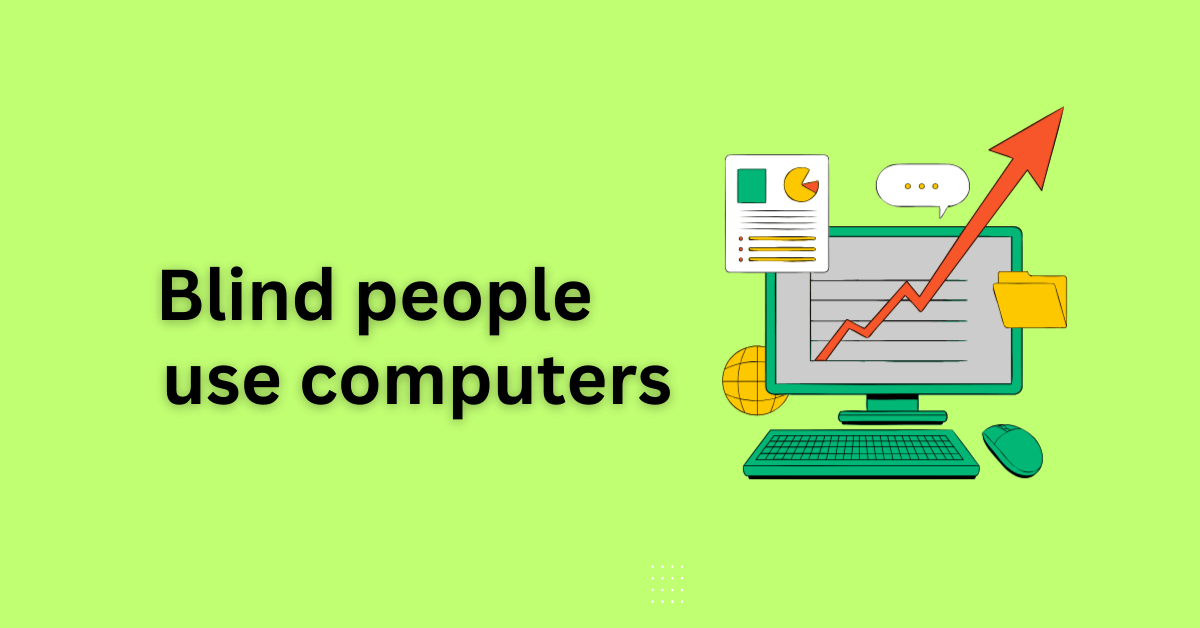In today’s world, where everything is done using computers, knowing how to use them is really important. But for people who can’t see well or at all, using computers is even harder. Even though not being able to see might seem like a really big problem, new technologies have helped a lot. There are assistive technologies that use touch and speech output to help blind people use computers just like anyone else. In this blog, we’ll talk about how do blind and visually impaired people use computers and the helpful smart technologies they use. These technologies may amaze you!
Keep reading to uncover how blind and visually impaired people use computers without being able to see the screen.
How do blind people read screens of computers?
Using a computer necessitates interacting with the screen visually, which raises the question of how blind people can utilize computers. Blind people use special software called screen readers to help them ‘read’ the screens of computers.
These screen readers use a synthesized voice to read out the on-screen information or can be connected to a braille display to convey the information through touch. When users move their cursor or select something on the screen using keyboard shortcuts and commands, the screen reader describes the elements present, enabling them to comprehend and navigate the content.
It’s like having a digital assistant that communicates verbally, reads out text, dialog boxes, icons, file names, and the operating system interface, or provides information in braille. This enables blind individuals to access and interact with computer interfaces and content effectively.
Popular screen readers include JAWS (Job Access With Speech), NVDA (NonVisual Desktop Access), and VoiceOver (for Apple products).
Furthermore, for those with low vision, built-in magnifiers offer assistance by allowing users to zoom in on specific parts of the screen. These magnifiers can be adjusted and expanded according to individual preferences and requirements, enabling more comfortable reading and navigation experiences.
The next important thing to understand is the input methods that blind people use to operate computers.
How a blind person uses a computer Keyboard?
Blind individuals use various methods to work with computer keyboards. Depending on their level of vision and ability, they adopt different techniques:
1. Screen Readers and Touch Typing: For those who are completely blind, they often use screen reader software that speaks out the text on the screen and guides them through menus, dialog boxes etc. and combine this with touch typing, where they’ve memorized the keyboard layout and can type without needing to see the keys. As they types on the keyboard, the screen reader reads aloud the characters they type. This real-time auditory feedback helps them confirm that they are entering the correct information.
2. Magnification Software and Touch Typing: People with some level of vision might use magnification software to enlarge the input section on the screen. They also use touch typing to type without looking at the keys.
3. Braille Keyboards: Braille keyboards are designed with raised dots that represent Braille characters. Blind individuals can feel these dots with their fingers and type Braille text, which the computer can then interpret.
4. Speech-to-Text Technology: Some blind individuals use speech-to-text software. They speak, and the computer converts their words into text on the screen. This method is particularly helpful for tasks like writing and messaging.
Do Popular Operating Systems Support Screen Readers?
Popular operating systems are designed to cater to the needs of individuals with disabilities, including those who are blind or have low vision.
1. Microsoft Windows:
•Windows offers a variety of accessibility features, including Narrator (a built-in screen reader), Magnifier (for screen magnification), high-contrast themes, and speech recognition.
•The Ease of Access Center centralizes settings for various accessibility features, making it easier for users to configure their preferred options.
•Despite having a basic built-in screen reader called Narrator, its features are quite limited. Typically, individuals opt for more robust options like “Jaws For Windows,” a commercial product, or “NVDA,” an open-source and exceptionally high-quality solution, to effectively interact with their computers.
2. macOS:
•macOS includes VoiceOver, a powerful screen reader, as well as Zoom (for screen magnification) and Siri (voice recognition).
•Accessibility settings allow users to customize text-to-speech voices, enable visual enhancements, and configure gesture-based interactions on trackpads.
•Braille displays are well integrated into macOS, allowing users to read and interact with content using tactile feedback.
3. Linux:
•Various Linux distributions offer accessibility options, with some distributions like Ubuntu having a dedicated “Accessibility” section during the installation process.
•Orca is a popular screen reader for Linux, providing support for various applications and environments.
•Linux’s open-source nature allows for customization and development of accessibility tools to suit individual needs.
The above-mentioned operating systems allow blind people to use and operate computers with ease.
What activities can blind people do with computers?
Blind people can engage in a wide range of activities using computers, thanks to assistive technologies and accessible design. Here are some activities they can participate in:
1. Communication: Blind individuals can send and receive emails, use messaging applications, and participate in social media platforms to stay connected with friends, family, and colleagues.
2. Education: They can access online courses, educational materials, and digital textbooks to continue learning. Screen readers and braille displays help them read and understand the content.
3. Work and Productivity: Blind people can use computers for various work-related tasks such as writing documents, creating presentations, managing schedules, and participating in virtual meetings. Screen readers and accessible software enable these activities.
4. Web Browsing: With screen readers and accessible web browsers, blind users can navigate the internet, search for information, and interact with websites.
5. Entertainment: They can enjoy various forms of entertainment, including listening to music, podcasts, audiobooks, and watching movies or TV shows with audio descriptions.
6. Programming and Coding: Blind programmers and developers can write code using specialized integrated development environments (IDEs) that are designed to work well with screen readers.
7. Online Shopping and Banking: Accessible websites and apps allow blind users to shop online, manage their finances, and carry out online transactions independently.
8. Social Networking: Blind individuals can use social media platforms to share updates, engage in discussions, and connect with people who share their interests.
9. Art and Creativity: Using accessible software, blind users can engage in creative activities such as digital art, music composition, and writing.
10. Access to Information: They can access news articles, blogs, and online resources to stay informed about current events and topics of interest.
I hope the information above helped you understand how blind people use computers. If you or someone in your family is dealing with blindness, this knowledge could be valuable.
Maybe you’re thinking, “They haven’t really tried computers.” That’s where you can make a difference. Show them the world of computers and the screen reader. It’s like giving them a key to open a door of opportunity.
If this information touched you or could help others, please share this post. Let’s spread the word and inspire more people to embrace the possibilities of technology, no matter their sight. Together, we can make technology more inclusive for everyone.

